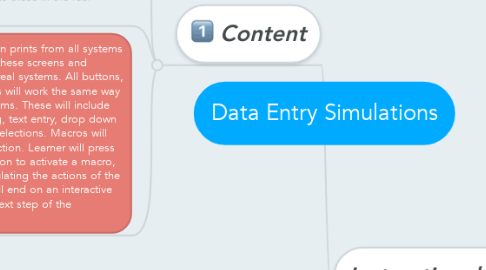Data Entry Simulations
by Sarah Jackson

1. Content
1.1. Claim Forms: replicate various examples (not real member/provider data) common to DE dept. Replicate the EDSS and iDRS systems to find these examples.
1.1.1. Use the real Process Instructions (PI). Have learners open this in separate window, which mirrors real process. Instructions in the simulation will tell them to go find the PI.
1.1.1.1. Have learners access simulated COSMOS system in Storyline2 course. Includes log in screens using the Macro.
1.1.1.1.1. Have learners follow the steps in the PI and enter the data from the claim form into the CL104 screen in COSMOS. Simulation will mirror every step of the actual process including messages that pop up along the way and how fields look when they have been updated.
1.2. Use real claims and capture them in the system using real member/provider data. Provide real document control numbers (UFE: United Front End) and have learners locate these in the real EDSS and iDRS systems.
1.3. All images and screen prints from all systems will exactly mirror what these screens and images look like in the real systems. All buttons, function keys, and fields will work the same way they do in the real systems. These will include clickable items, scrolling, text entry, drop down menus, and radio dial selections. Macros will also mirror real world action. Learner will press the keystroke combination to activate a macro, a video file will run simulating the actions of the macro and the video will end on an interactive screen that shows the next step of the simulation.
2. Instructional Methodology
2.1. Problem solving: Learners must discern the appropriate actions using available tools (claim form, PI, COSMOS screens).
2.2. Gaming: simulations are timed with goal timeframes for completing the claim or with the goal that each subsequent attempt takes less time.
2.3. Demonstration/Teach back: either Facilitator can use the simulations to teach the topics and/or Learners demonstrate the process to one another and teachback the process to one another.
2.4. Cooperative learning/collaboration: Learners work with partners or small groups to process claims.
2.5. Drill and practice: Specific steps learned, practiced, and honed.
2.6. Direct instruction: Facilitator uses simulation in conjunction with lecture or other facilitation techniques to teach topic.
2.7. Guided discovery: Learners used existing tools and simulations to learn the topic with little or no prior instruction.
2.8. Feedback: Positive and corrective feedback incorporated along the way that displays based on the actions taken by the Learner.
2.9. Simulation: The purpose of this tool is to simulate the end to end process for this job.


